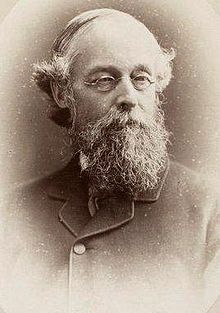Alfred Richard Cecil Selwyn
Alfred Richard Cecil Selwyn (born July 28, 1824 in Kilmington , † October 19, 1902 in Vancouver ) was a British geologist who was the director of geological surveys in Victoria in Australia and Canada .
Life
His father was a canon of Gloucester Cathedral , his mother the daughter of Lord George Murray, Bishop of St. David's . He was educated by private tutors and in Switzerland and joined the British Geological Survey in 1845, where he mapped western England and northern Wales under Andrew Ramsay and Henry De la Beche . Selwyn was director of the Geological Survey of Victoria from 1852 until its dissolution in 1869 . In addition to overseeing the creation of over 60 geological maps (whereby he adhered to the highest standards), he wrote several reports of the survey himself and discovered a gold deposit near Melbourne (Caledonian Gold Field, 1854) and a coal deposit in Tasmania (1855). There he increased his excellent reputation as a geologist and organizer, which he had already gained in England, and then became director of the Geological Survey of Canada, which he remained until 1894.
He had been married since 1852 and had three sons and a daughter.
Honors
In 1871 he became a fellow of the Geological Society of London , in 1874 of the Royal Society and in 1878 he was made a Knight of the Legion of Honor. In 1882 he was accepted into the German Academy of Sciences Leopoldina . He received the Murchison Medal in 1876 and the Clarke Medal of the Royal Society of New South Wales in 1884 . In 1886 he became CMG , in 1892 he was elected to the American Academy of Arts and Sciences .
The Selwyn Range in the Canadian Rockies is named after him.
Web links
Individual evidence
- ^ Member entry by Alfred Selwyn at the German Academy of Natural Scientists Leopoldina , accessed on November 12, 2015.
| personal data | |
|---|---|
| SURNAME | Selwyn, Alfred Richard Cecil |
| BRIEF DESCRIPTION | British geologist |
| DATE OF BIRTH | July 28, 1824 |
| PLACE OF BIRTH | Kilmington |
| DATE OF DEATH | October 19, 1902 |
| Place of death | Vancouver |
